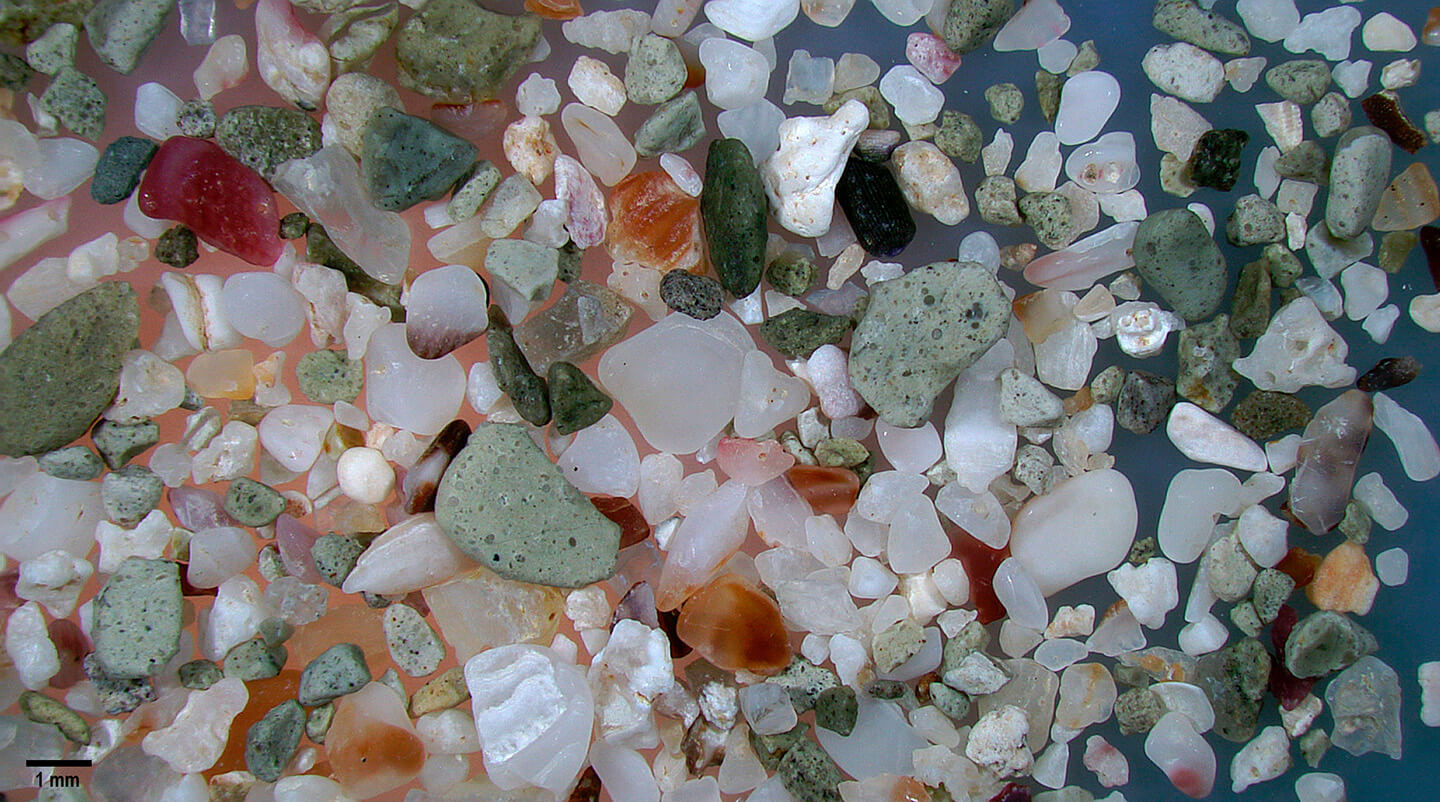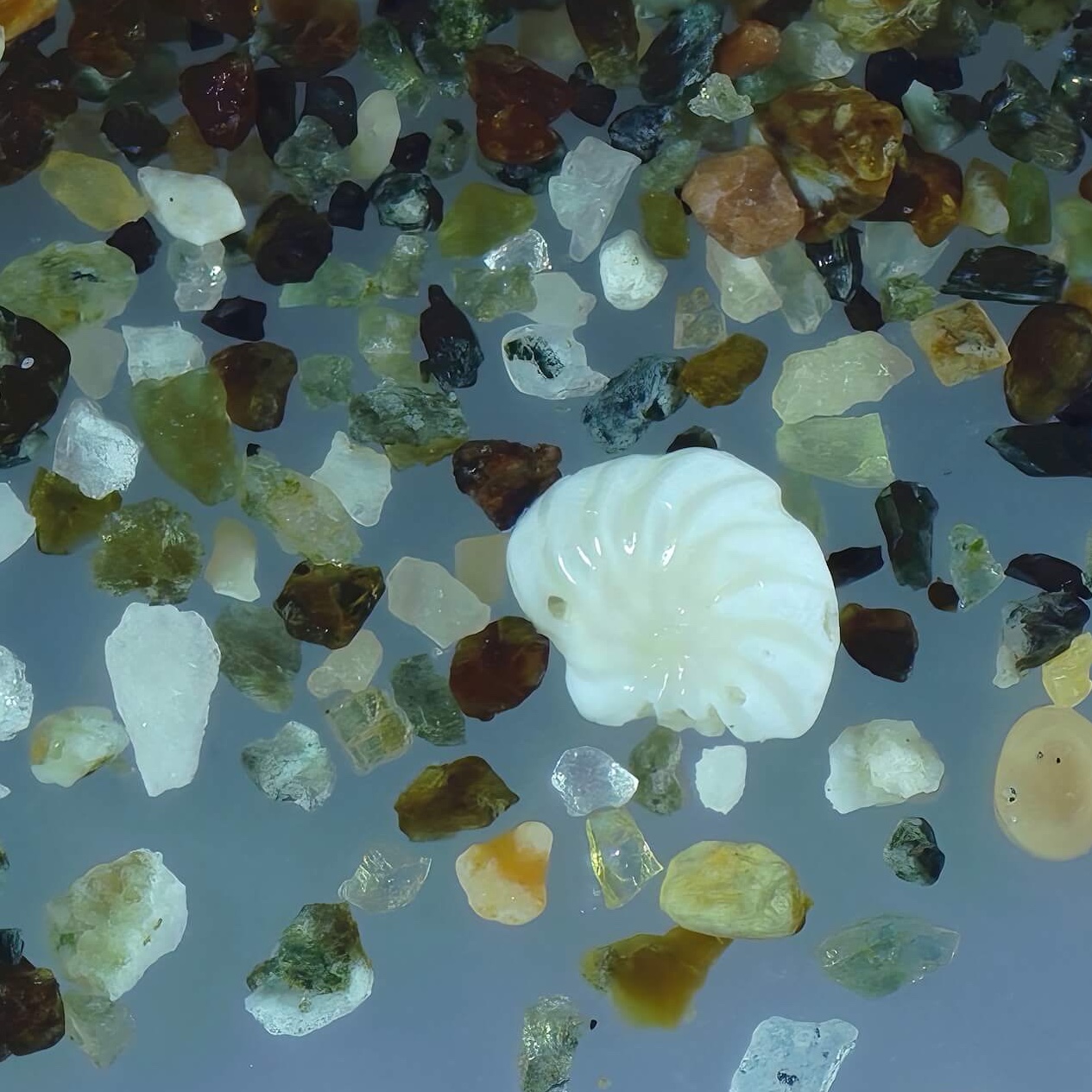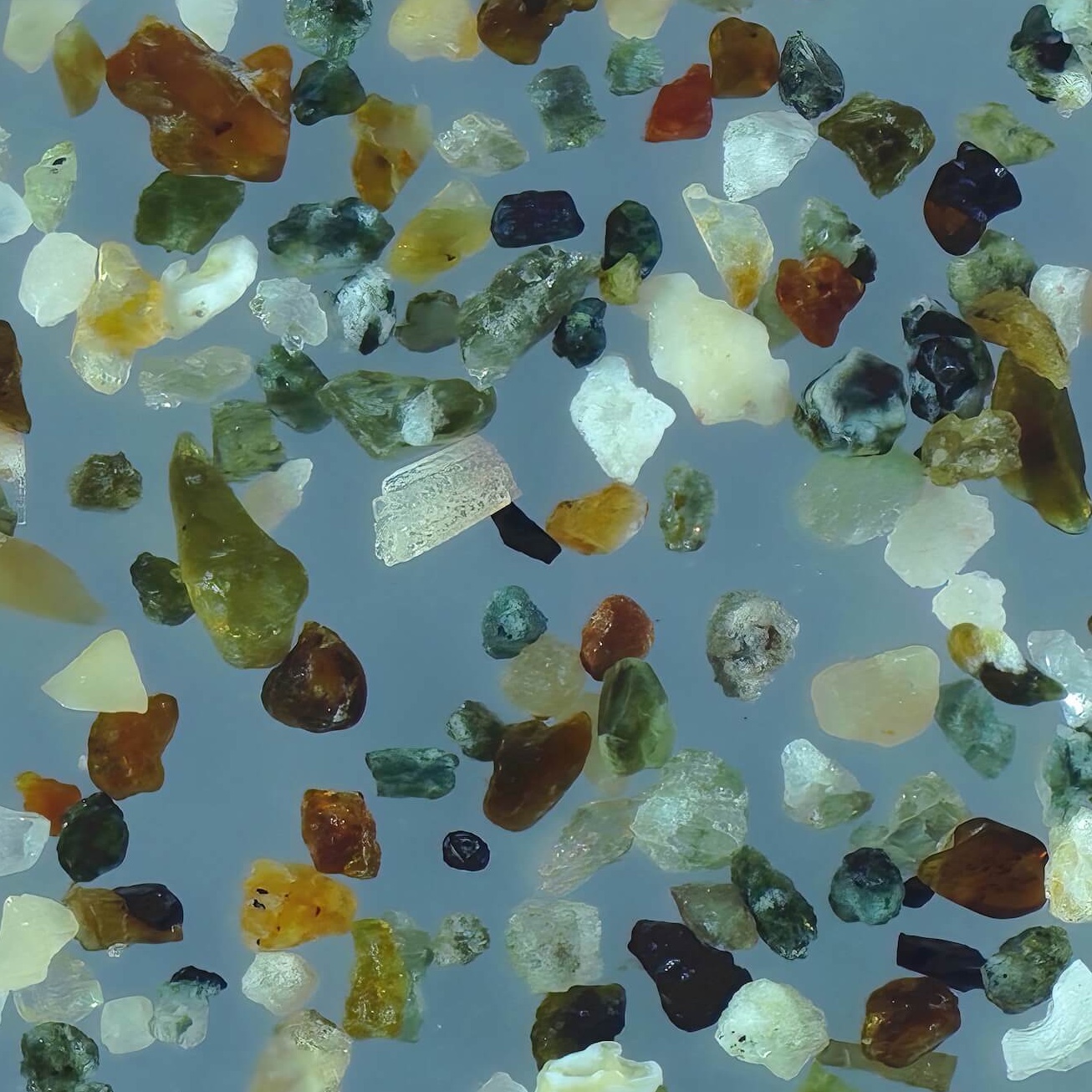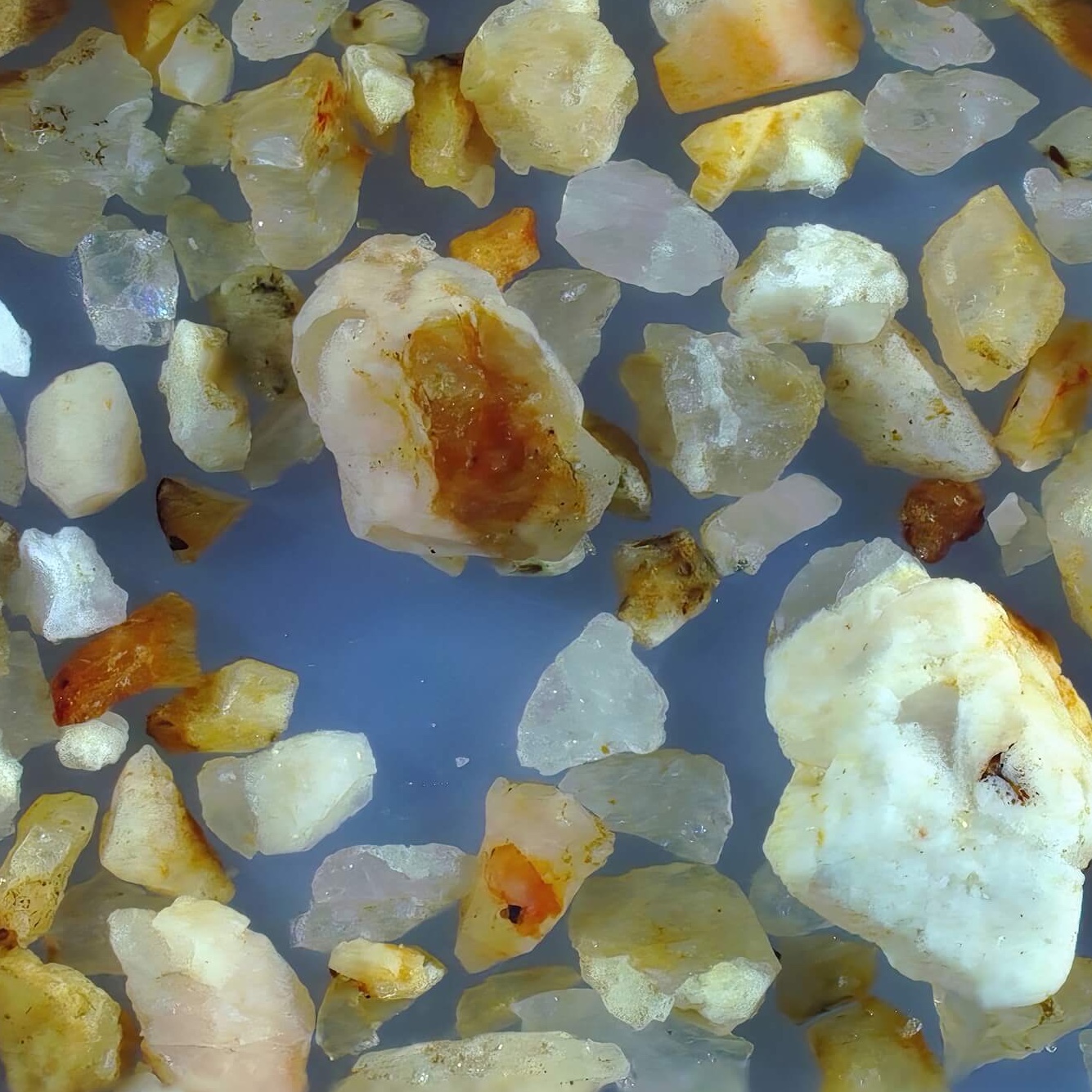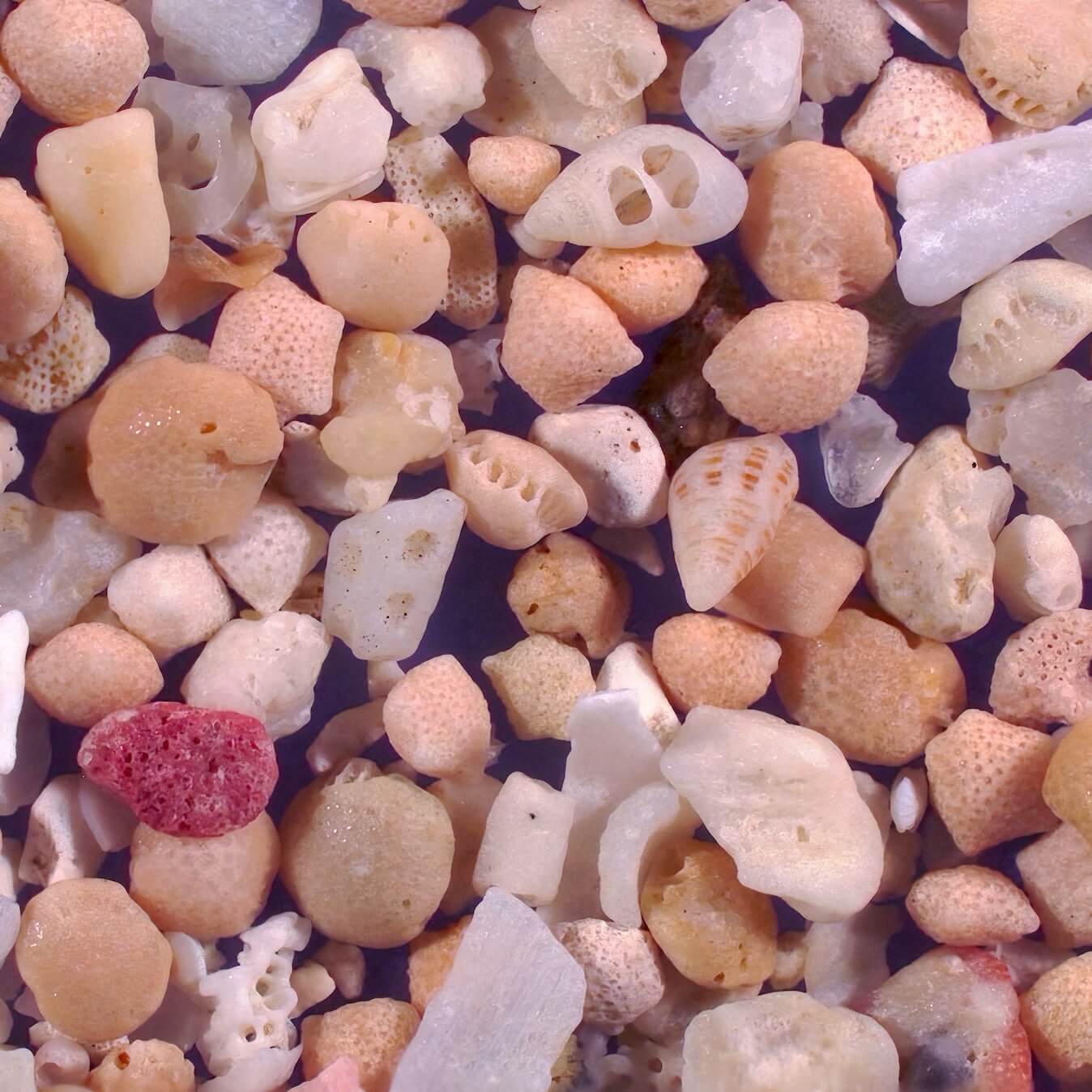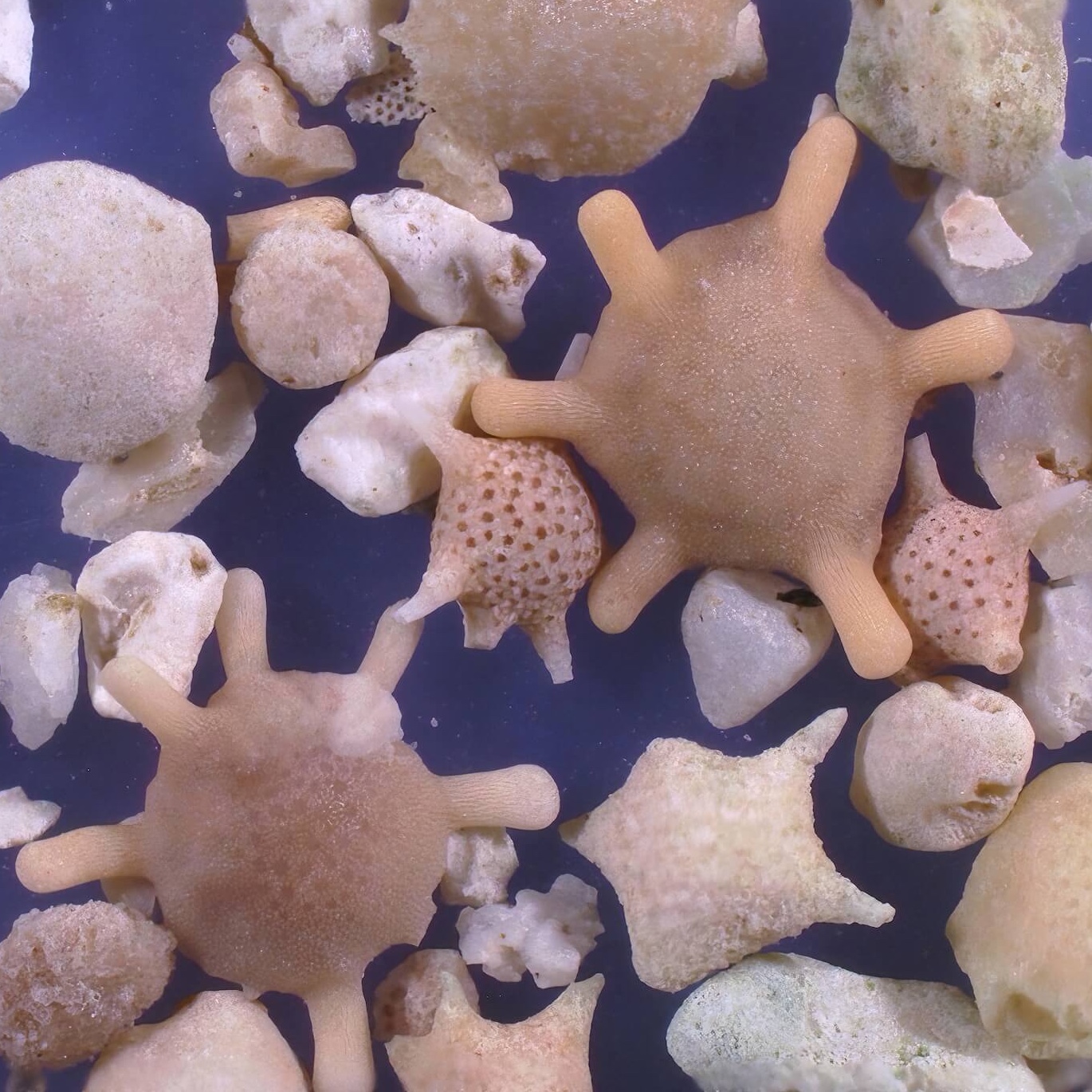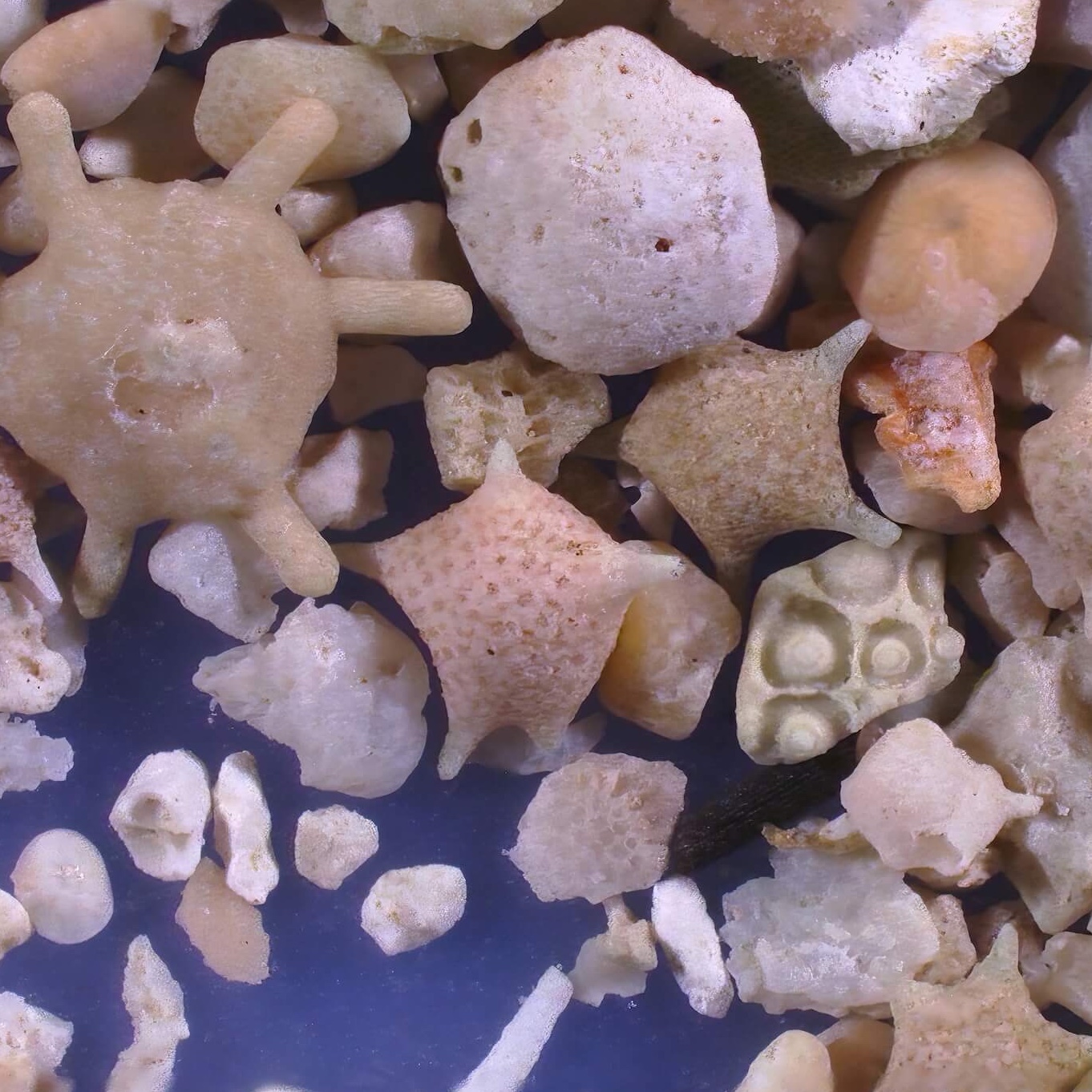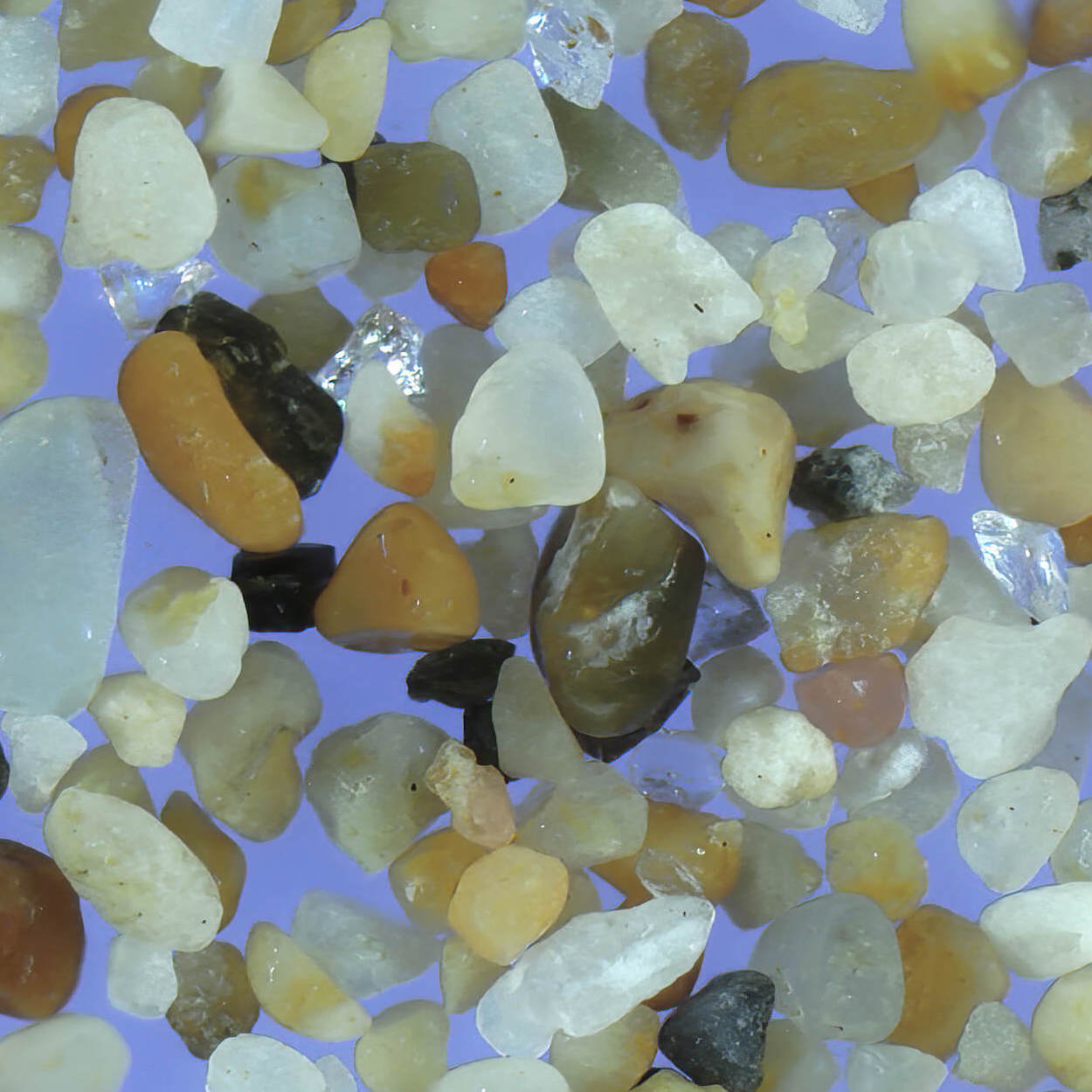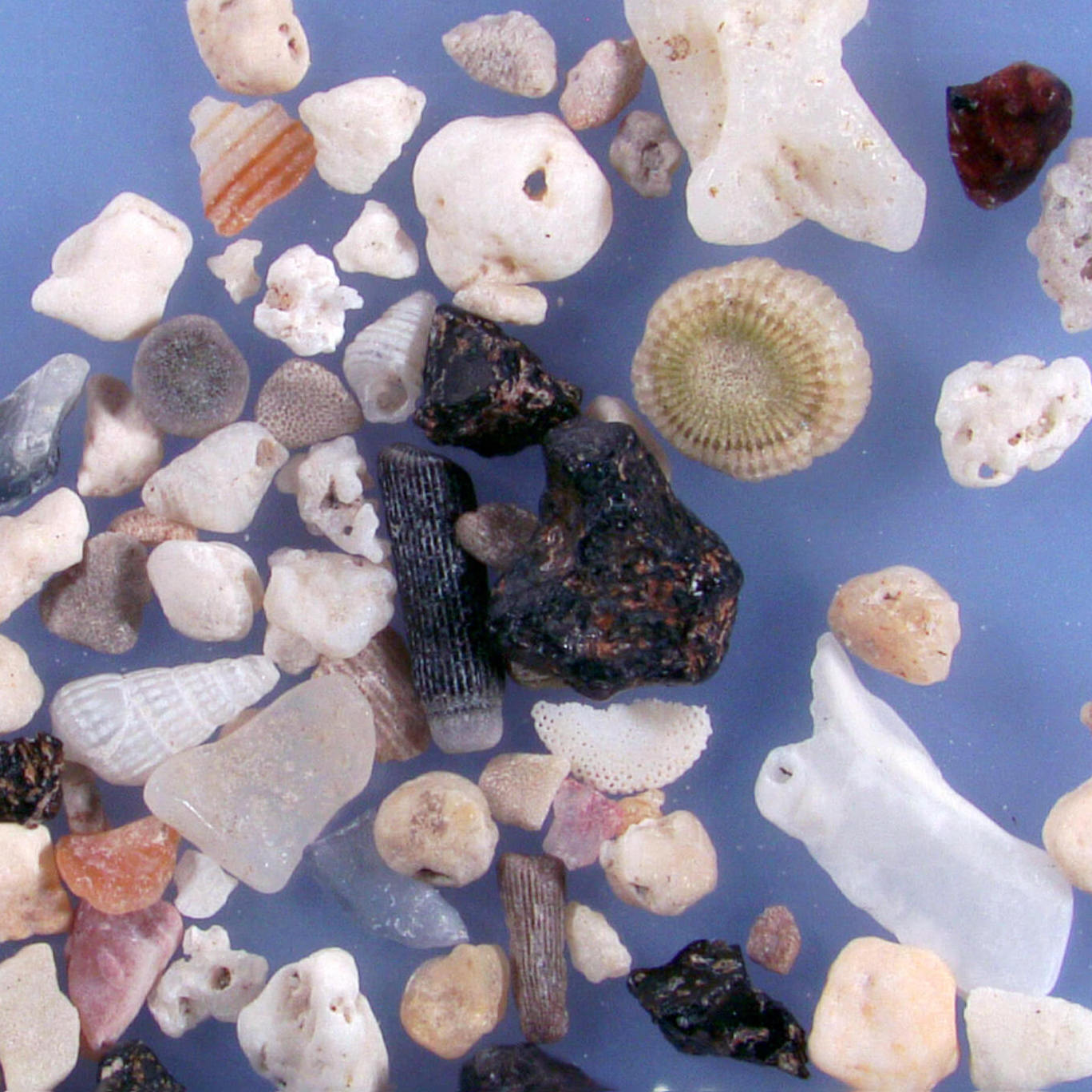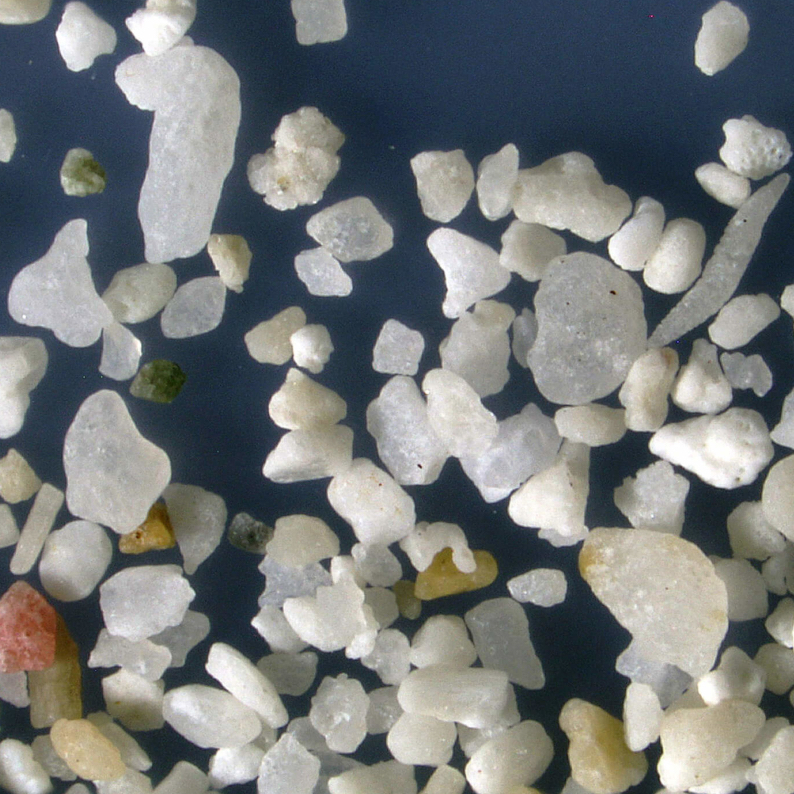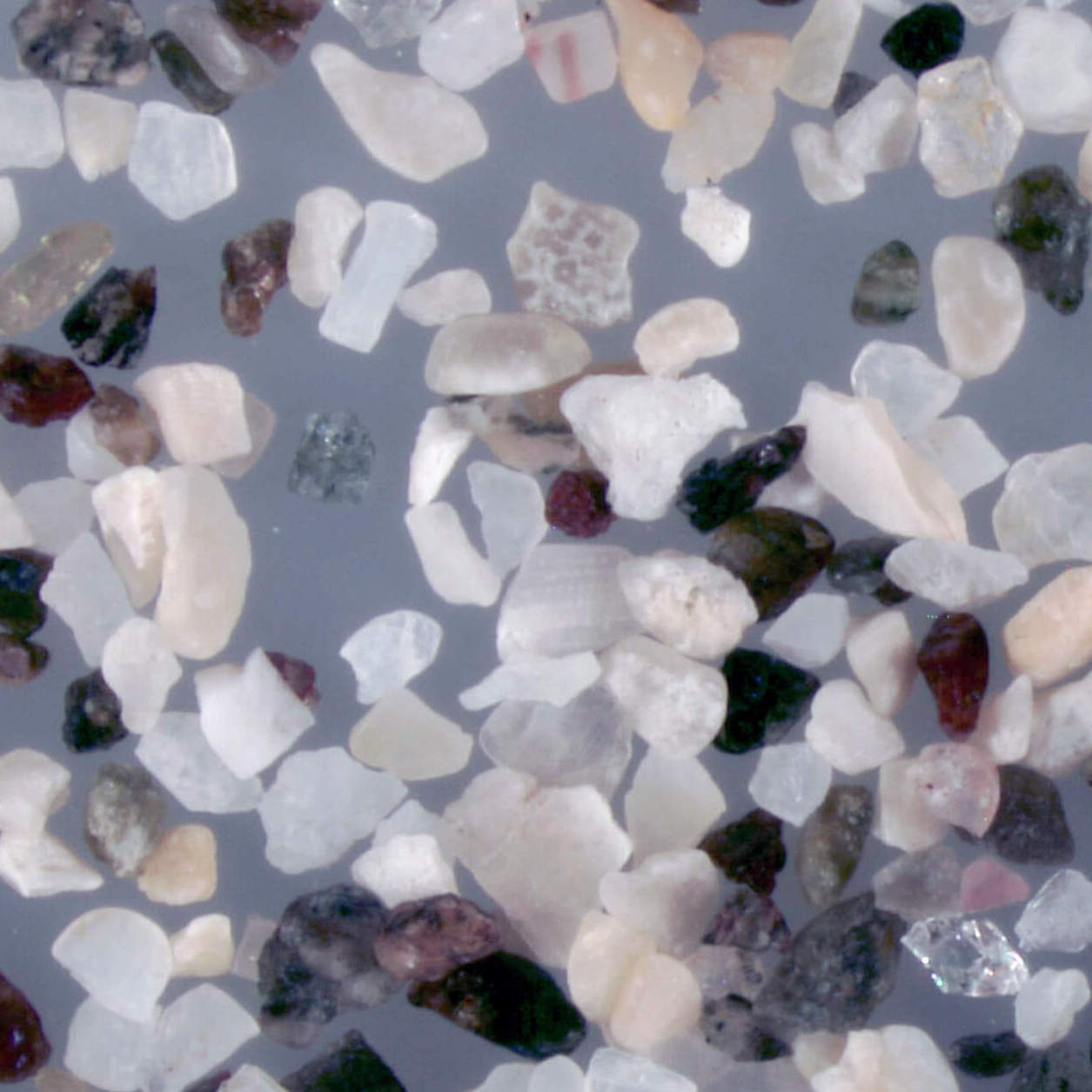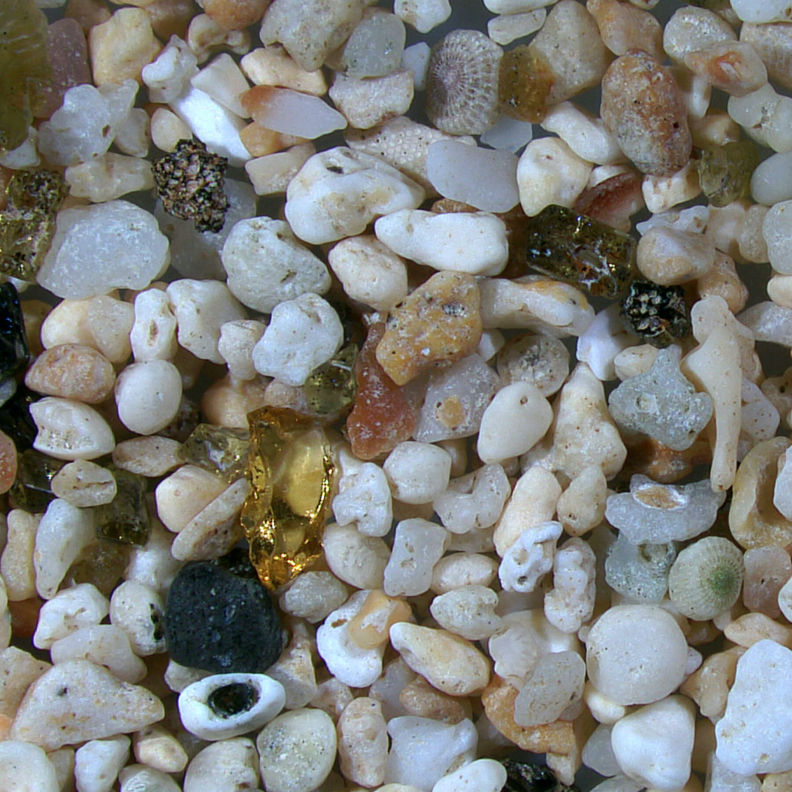Explore the Hidden World of Sand
Under microscopic magnification, the unique beauty and individual character of sand grains reveal a diverse origin reflecting geological history and marine life biodiversity. Sand is everywhere on earth – on our beaches, in our deserts, and on the bottoms of lakes, rivers and oceans. Sand particles are coarser than silt but finer than gravel, ranging in size from 0.02 to 2 mm. They are created when weather and chemicals break down terrestrial rocks, minerals, marine bivalves, corals, mollusks, bryozoans, and foraminifera.
Every Grain is Unique
There are roughly 8,000,000,000 grains of sand per cubic meter of beach, and roughly 700,000,000,000 cubic meters of beach on Earth. That’s 5 sextillion grains of sand. An incomprehensible number, and yet every sand grain is microscopically unique. Like a snowflake, no two are the same.

Sand Tells a Story
The microscopic features of sand from beaches throughout the world tell a story about the local geography, geological history, and biogenic aquatic life living in adjacent seas.


Aquatic Life in Sand
Microscopic grains of sand originate from sea life including corals, sea urchins, colorful fragments of bivalves, calcareous remains of numerous unicellular organisms such as foraminifera and bryozoans, and structural components of algae and sponges.

Mineral Composition of Sand
The geologic mineral composition of sand is influenced by plate tectonics, volcanic activity, and mountainous erosion occurring over many millions of years.

Photographs of Sand Under a Microscope
Lindisfarne (Holy Island)
Lindisfarne (also known as "Holy Island") was formed from rocks of a type of geological intrusion called a sill and includes a mix of sedimentary, intrusive, and extrusive igneous rocks...
Gypsy Cove
The Falkland Islands are a remote South Atlantic archipelago with rugged terrain and cliff-lined coasts located on a projection of the Patagonian continental shelf...
Alexandria
Geologically Alexandria's coastline is made up of soil sediments, oolitic sand and clay, and various types of limestone and dolomite...
Ao Phang Nga Beach
Ao Phang Nga National Park is world renowned for the white sandy beaches and crystal clear water as well as dramatic cliffs that have been formed...
Nungwi Beach
Zanzibar is home to powdery white sand, calm crystal blue waters, and exotic flora and fauna. Being near to the equator...
Two Sisters Beach
Conero’s Two Sisters beach consists primarily of large limestone sand grains formed from marine sediment during the Jurassic period...
Kujukuri Beach
Unlike Japan's typical rocky and rugged coastline, Kujukuri Beach is a 66-kilometer length of sandy beach...
Futamiura Ise
The coastline here consists of an intricate pattern of inlets and islands and offers magnificent views...
Playa Balneario de Carolina
The island foundation is comprised of a plutonic and volcanic base with limestone formations formed from calcium carbonate shells...
Waimanalo Beach
The soft white sand of Waimanalo Beach is primarily composed of smoothly worn grains of marine organisms including forams and bivalve fragments...
Titlow Beach
As is common on some Pacific Northwest shores, instead of fine sand the shores of Titlow Beach are lined by small rocks...
Shichirigahama Beach
The sandy beach of Shichirigahama is formed by the erosive action of the sea and includes strata of sedimentary rock with occasional fossils...
LaPush Beach
LaPush Beach consists of geological sand grains featuring clear, cloudy and colored quartz grains along with black basaltic sand grains...
Kannonzaki Beach
Kannonzaki beach is set in a natural environment that protrudes into Tokyo Bay and boasts of golden sand and crystal clear water...
Gun Beach
Gun Beach sand is comprised of marine sand grains with a high percentage of partially worn light tan Baculogypsina sp. foraminifera species...
Newfoundland Beaches
The west coast of Newfoundland with its 550-million-year-old volcanic and sedimentary rock is home to some of the oldest rocks in the world...
Kalithea Beach
This beach sand sample is comprised mostly of a wide spectrum of colorful igneous and metamorphic rock including dark basaltic rock...
Port Sanilac
Clear and cloudy quartz and tan feldspar are present along with dark volcanic rock. The dark rock grains are likely basalt...
Ibusuki-Yamakawa
The Ibusuki volcanic field is an area of current volcanic and geothermal activity at the tip of the Satsuma Peninsula...
Baile Mór-Isle of Iona
Mixed light and dark small sand grains are primarily geological with some small bits of marine shells...
Plage d’Essaouira
Colorful mixture of marine fragments including sea urchin spines, light and dark mollusk shell fragments, forams and bits of coral...
Ain Diab Beach
Ain Diab beach stretches for about three kilometers along the Atlantic Ocean and is often referred to as Casablanca's version of Miami...
Colombia Beaches
Samples of sand collected from La Boquilla Beach, Cholon Beach, and Encantada Beach in Columbia feature geological and marine fragments...
Ölüdeniz
Famous for its pure, turquoise, aquamarine waters and pebble beach, the Ölüdeniz beach is known for its beautifully serene blue lagoon...
Çanakkale
This sand includes quartz and feldspar sand grains, many with right angle edges, along with greenish and black volcanic sand grains...
Phaselis
The darker sand grains of Phaselis beach reflect the predominantly geological origin of the beach sand. Small fragments of biogenic grains...
Kusadasi
Kusadasi is a beach resort town situated along a gulf on the Aegeqn coast. This sand features smooth larger sand grains along with smaller rough-edged grains...
Göreme
Sand collected from around Göreme’s unique rock formations is characterized by large amounts of small and larger fragmented silica and feldspar...
Angel Road
Angel Road sand is a mixture of larger and smaller light and dark tan sand grains that show minimal evidence of smoothing by wave action...
Akaishi Beach
Akaishi Beach sand primarily consists of marine sand grains representing broken fragments of coral and forams worn smooth by wave action...
Miyajima Beach
The composition of the beach consists primarily of silt, sand, and crushed seashells. The shape of the sandy beach is influenced by...
Minami Beach
Minami Beach is covered with white and tan marine sand grains representing several different foraminifera species...
Kondoi Beach
Kondoi beach is known for white soft sand and shallow, crystal-clear emerald green water. It is one of the longest beaches in Okinawa...
Hasaki Beach
Hasaki Beach is covered by essentially 100% small geological sand grains with clear quartz, tan and yellow feldspar...
Doigahama Beach
The Doigahama site is located in the center of the small plain on the coast of Hibiki Bay, where stunning white sand dunes...
Fukuura Beach
Fukuura Beach sand is a mixture of dark and lightly colored volcanic sand grains, large and small transparent quartz sand grains...
Nakamura Beach
Originally part of the Asian mainland, the volcanic Oki Islands separated from the Asian mainland 10,000 years ago. Four of 180 islands that make up...
New Zealand
Most of the South Island consists of rock known as greywacke that under heat and pressure was transformed into schist in the west and south...
Rosh Hanikra
Sand collected from this Rosh Hanikra beach consists of various marine shell fragments along with piece of mineral sand grains...
Achziv
Sand along the Mediterranean coast of Israel consists mostly of marine and shell fragments with less dark volcanic and clear quartz sand grains...
Casa del Mar
Casa del Mar sand is a mixture of tan, black and off white sand grains representing a mixed biogenic and geological origin...
Orient Beach & Montauk Beach
Ages ago, what is now New England and New York State was covered by the great Wisconsin glacier. About ten thousand years ago the glaciers melted leaving behind sand, rock and soil...
Galapagos Island
Galapagos beaches have a characteristic mixture of light and dark sand grains reflecting its geological origin and abundant aquatic marine life, including worn fragments of tan and reddish bivalve chards...
Tikchik River
The Tikchik River is located within Wood-Tikchik State Park, the largest state park in the United States. The sand here is a mixture of variably sized dark grayish-tan sand grains...
Inishmore
Sand samples from two locations in Inishmore. Distinct tan, red striped, and white shell fragments are present along with a collection of dark metamorphic sand grains...
Barbados
Barbados beaches are characterized by uniform fine white sand with a sprinkling of pink and red sand grains. Pink and red fragments of marine organisms stand out in contrast to shell and calcareous algae...
Qurum Beach
Aside from occasional clear and reflective quartz sand grains and some small black grains, some of which may be volcanic, the majority of the sand grains are smooth white and tan shell fragments...
LaSerena, Bay of Coquimbo
White and tan marine shell fragments and gray and black intrusive igneous rock show the terrestrial and marine components of a LaSerena coastal beach...
Lima, Peru
This sand is a mixture of clear quartz grains, light yellow-tan rounded feldspar grains with some right angle edges, and darker greenish-gray metamorphic sand grains...
Kaloko-Honokohau National Park
A mixture of dark and white sand grains present a colorful view of the diverse sand at Kaloko-Honokohau beach. Dark red and black porphyritic volcanic grains and varied colored sea urchin spine fragments...
Trunk Bay Beach
A variety of organic sand grains including red foraminifera (forams), a clear triangular sponge spicule in the center, short rods of calcareous algae, and bits and pieces of coral...
Little Lameshur Bay
Only 9 miles long and 2 miles wide, St. John boasts of lush emerald mountains, hills and valleys without many flat areas, and soft white coral sands on numerous near-deserted tranquil beaches...
Little Cinnamon Bay
Although St. John is a volcanic island and part of a submarine mountain range extending from Cuba to Trinidad, sand on recreational beaches is primarily biogenic. This beach sand...
Honeymoon Beach
A sand mixture of calcified algae, coral fragments, bits of mollusk shells, and pale and red forams reflects the diversity of adjacent sea life surrounding this island. Most of these sand grains...
Hawksnest Beach
This mixture of white and tan sand grains includes grooved fragments of mollusks and fragments of calcareous algae and smoothly worn forams. The red grains are fragments of the foraminifera...
Hansen Bay Beach
This large mixture of sand grains is essentially of biogenic origin representing bleached coralline algae and fragments of coral with the exception of a larger dark grain of volcanic origin...
Francis Bay Beach
Among the larger sand grains are light tan and brown mollusk shell fragments. The black grain with thin vertical white stripes just below center is also a mollusk shell fragment while the smaller...
Sæból
A mixture of tan to white opaque fragments of mollusk shells along with some purple and gray shell fragments (upper center) accompany the numerous dark gray to black sand grains of volcanic origin...
Reynisfjara (Black Sand Beach)
Reynisfjara Beach sand is a mixture of variably size black and gray grains along with a few white and red grains. This sand is of volcanic origin with a conspicuous absence of any fragments...
Rauðasandsvegur
Variably sized light tan, dark tan and white small fragments of sea shells with occasional larger darker fragments characterize this beach that stretches for over 10 kilometers...
Hofgarðar
This sand is a mixture of white, tan, gray and black sand grains. All are smoothly worn from long exposure to wave action. White and tan grains are worn fragments of marine shells...
Hellnar
This sand is a mixture of white, tan, gray and black sand grains. White and tan grains are fragments of marine shells. Dark sand grains are fragments of basalt and other metamorphic rocks...
Djúpavík
Djúpavík, a small village in the Northwest of Iceland in the Westfjords region, consists of seven houses, a hotel and the ruins of a herring factory. In the mid 1930’s Djúpavík...
Jökulsárlón (Diamond Beach)
The sand at Diamond Beach consists mostly of dark gray and black volcanic rock broken down by ocean and glacier rivers over centuries to form the black sand beach. White, tan and reddish sand grains also of...
Playa de Las Conchas
Playa de Las Conchas, a remote beach on a small volcanic island, consists of microscopic marine fragments of smooth mollusk shell sand grains with occasional larger white fragments...
Kynance Cove
Known for its striking beauty, unique geomorphology, and picturesque coves, the Lizard Peninsula is legendary for its 18th century smuggling trade and shipwrecks in nearby reefs. This area, known as...
Dream Beach, Bali
The Island of Bali, like most islands of the Indonesian archipelago, resulted from the tectonic subduction of the Indo-Australian plate under the Eurasian plate. The tertiary ocean floor, consisting of ancient marine...
Sand Beach, Maine
Sand Beach is comprised of fine-grained sand while other Maine beaches that are open to waves and storms consist of pebbles, cobbles and boulders. In contrast to the mixed marine and geological...
Punta del Este, Uruguay
The thick tan sand is derived primarily from igneous and highly folded metamorphic rock and includes quartz and reddish-tan alkali feldspar. Smoothly rounded sand grains...
Jeju Island
With a natural geology like none other in the world, this elliptical island is comprised of Holocene volcanic rocks resulting from several volcanic eruptions with the most recent...
Tazones, Asturias
Auturias beaches, such as Tazones in northern Spain, face the Catabrian sea that is the southern part of the Bay of Biscay. The diverse benthic habitat in the Catabrian Sea provides hotspots for biodiversity...
Syotenkyo, Kazuranohama
Syotenkyo Kazuranohama Beach is a long swimming beach of white sands, green pines, and shallow waters sandwiched between the Sea of Japan and Kumihama Bay in the northwesternmost region of Kyoto...
Santa Maria del Mar
The seas surrounding Cuba have a varied and abundant biomass including diverse corals, soft sponges, sea grass beds, and more than 7000 species of fish, crustaceans and other marine life...
Sally’s Cove, Newfoundland
The west coast of Newfoundland with its 550-million-year-old volcanic and sedimentary rock is home to some of the oldest rocks in the world. This area is a visible example of the obduction process...
Playa Camaronal
Dark volcanic sand is carried from the adjacent rugged mountainous terrain and deposited at the mouth of the Ora River. In contrast, nearby Isla Chora sand is primarily biogenic...
Isla Chora
Isla Chora sand is primarily biogenic with a scattering of variably sized light greenish-gray porphyritic basalt stippled with vesicles that have been filled with microscopic quartz and other mineral crystals...
Elba Island
In terms of geological time, Elba Island is young with variable topographical features. Highly variably sized sand grains originate from geological activity 50 million years ago...
Ramla Bay, Gozo
The tan color sand consist primarily of compacted skeletal remains of ancient globigerina foraminifera. The surrounding Mediterranean water have contributed additional biogenic components...
San Fruttuoso
San Fruttuoso beach is a mixture of larger and small sand grains reflecting the minerals of the adjacent Portofino mountainous terrain with occasional biogenic sand grains...
Hirakubozaki, Ishigaki Island
Beach sand from the Hirakubozaki area is rich in well-rounded biogenic grains representing skeletal remains of foraminifera species and fragments of coral, coralline algae, various shells...
Wailea Beach
The sand is composed of a mixture of biogenic and volcanic grains. The biogenic marine grains are smoothly rounded as a result of the famous strong winds and waves of Maui...
Bay of Banderas
Beach sand from the Bay of Banderas is a variable mixture of colorful sand grains mostly 1 millimeter or less in size with angular edges geologically indicative of relatively young sand...

